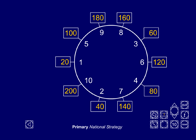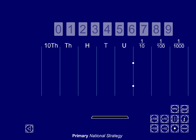Consolidation and practice
These resources are to support children in guided or independent work. Roll over the highlighted resources for a description.
Number dials

This interactive teaching program (ITP) is an ICT-based tool to support the exploration and recall of multiplication and division facts. Number dials ITP allows the child or teacher to generate sets of products of a central number and numbers from 1 to 10. The ITP can be used to practise multiplying and dividing by one- and two-digit whole numbers and decimals.
Moving digits

This interactive teaching program (ITP) is an ICT-based tool to support the exploration of place value. Moving digits ITP allows the child or teacher to place and move digits on a place value board, investigating the effects of multiplying and dividing by 10 or 100.
Opportunities to use and apply
Possible contexts include:
- Word problems involving decimal measures, e.g. A carton of juice contains 0.4 litres of juice. How many cartons are needed to have 2 litres of juice altogether?
- Measure problems, e.g. Gym mats are 1.6 metres long. If 5 mats are placed end to end, what total length will they make?
- Currency conversion, e.g. £1 is equal to about $1.4. What is the approximate value of £5 in US dollars?
- Division giving a decimal answer, e.g. Divide 9 by 5 giving your answer as a decimal.
- Missing number calculations, e.g.
 ÷ 8 = 0.04; 0.6 ×
÷ 8 = 0.04; 0.6 ×  = 4.2
= 4.2
Confirming learning
Ask probing questions such as:
- Find half of 4.7. Explain how you worked out the answer.
- Ryan says that 0.18 ÷ 9 = 0.2. Where do you think he went wrong? Explain his mistake and what he needs to do instead.
- A chocolate bar weighs 0.125 kg. I eat 1/5 of it. How much chocolate is this? How do you know?
- How does your knowledge of 56 ÷ 7 help you to calculate 0.56 ÷ 7?
- Divide 0.9 by 6. Explain each step of your working.
- 0.05 × 8 =
 ÷ 6
÷ 6
 × 6 = 3
× 6 = 3 = 0.6
= 0.6 Calculating
Calculating

